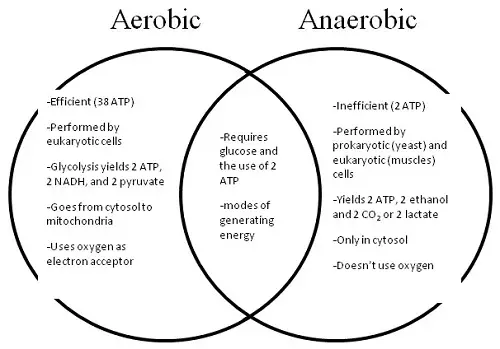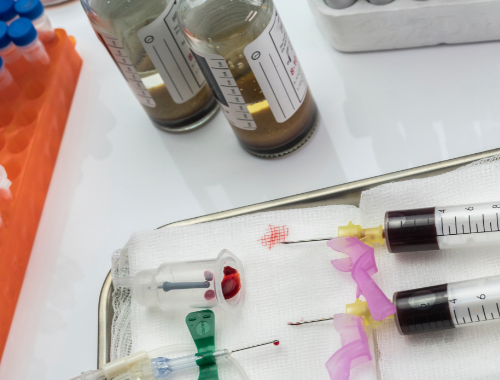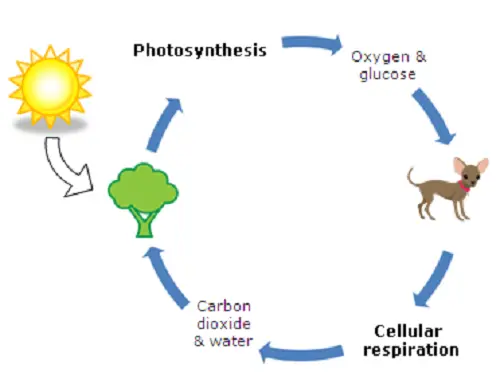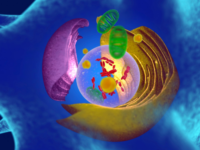The cellular respiration is a process of transferring the energy from glucose to adenosine triphosphate (ATP).
The cells break down the molecules of glucose and release energy, which is used to produce ATP. The energy of ATP is used to power the cell’s life functions.
Depending on whether oxygen is involved in the process as an acceptor of electrons or not, cell respiration is divided into:
- Aerobic respiration,
- Anaerobic respiration.

What is Aerobic Respiration?
Aerobic respiration requires the presence of oxygen. It has the following main phases:
- Glycolysis,
- Krebs cycle,
- Electron transport chain (oxidative phosphorylation).
As a result of the aerobic respiration, a total of 38 molecules ATP (2900 kJ energy) are produced via the breakdown of one glucose molecule.
The glycolysis is the first stage of the aerobic respiration. Its aim is to break down glucose and produce nicotinamide adenine dinucleotide (NADH), ATP, and pyruvates. Two ATP molecules are used for fueling of this process and 4 ATP molecules are produced. The glycolysis results in obtaining 2 pyruvates, 2 ATP (net gain) and 2 NADH from each glucose molecule.
The next stage – Krebs cycle – is a complex set of consecutive reactions. The Krebs cycle results in the production of two molecules ATP, using the pyruvates, produced in the previous phase.
The electron transport chain phase releases the energy remaining in the glucose after the glycolysis and the Krebs cycle. A total of 34 ATP molecules are synthesized during the electron transport chain. The role of the Oxygen in the aerobic cellular respiration is as an acceptor of electrons in the electron transport chain. It prevents the electrons from building up. Without oxygen, the electrons in the electron transport chain will remain stagnant, thus putting the production of ATP to a halt.
The chemical equation of the aerobic respiration is the following:
C6H12O6 + 6O2 → 6CO2 + 6H2O + 2900 KJ
What is Anaerobic Respiration?
The anaerobic respiration is conducted in the absence of oxygen. It has the following main phases:
- Glycolysis,
- Electron transport chain.
The first stage of the anaerobic respiration is the glycolysis, which produces 4 ATP molecules and consumes 2 ATP molecules, so the net gain is 2 ATP molecules. Many cells use oxidative phosphorylation under anaerobic conditions. The electrons resulting from the degradation of the glucose are transferred by a shortened electron transport chain to exogenous or endogenous acceptors.
Examples of anaerobic microorganisms are the sulphate-reducing bacteria, which transport electrons to sulphate (SO42-), reducing it to hydrogen sulphide (H2S). Other bacteria, called nitrate-reducing, transfer electrons to nitrates (NO3–), reducing them to nitrite (NO2–). Some nitrate reducers can reduce nitrate further to nitric oxide (NO) or nitrogen gas (N2). There are also microorganisms using carbon dioxide (CO2) as an acceptor of electrons.
Due to the absence of oxygen, in the process of anaerobic respiration, the glucose molecule is broken down only partially. The amount of energy (ATP), produced by anaerobic respiration, is significantly less than that, produced in aerobic respiration.
What are the Similarities Between Aerobic and Anaerobic Respiration
Similarities in Terms of “Definition”
The cellular respiration, both aerobic and anaerobic, is a process of transferring the energy from glucose to ATP. The cells break down the molecules of glucose and release energy, which is used to produce ATP. The energy of ATP is used to power the cell’s life functions.
Similarities in Terms of “Glycolysis”
Both aerobic and anaerobic respiration start with glycolysis – a process of splitting glucose molecules. This process consumes 2 ATP molecules and produces 4 for each glucose molecule, so the net gain is 2ATP molecules.
Similarities in Terms of “Electron Transport Chains”
- Both aerobic and anaerobic respiration use electron transport chains to release the energy remaining in the glucose after the previous stages (glycolysis and Krebs cycle for aerobic respiration and glycolysis for anaerobic respiration).
- The reactions in the electron transport chains require an acceptor of electrons (aerobic respiration – oxygen; anaerobic respiration – sulfate, nitrate, etc.).
Summary:
- The cellular respiration is a process of transferring the energy from glucose to ATP. The energy of ATP is used to power the cell’s life functions.
- Depending on whether oxygen is involved in the process as acceptor of electrons or not, cell respiration is divided into aerobic and anaerobic respiration.
- Aerobic respiration has three main phases: glycolysis, Krebs cycle, and electron transport chain. Anaerobic respiration has two main phases: glycolysis and electron transport chain.
- The glycolysis is a process of splitting glucose molecules. This process consumes 2 and produces 4 ATP molecules for each glucose molecule, so the net gain is 2ATP molecules.
- Both aerobic and anaerobic respiration use electron transport chains to release the energy remaining in the glucose after the previous stages.
- The reactions in the electron transport chains require an acceptor of electrons (aerobic respiration – oxygen; anaerobic respiration – sulfate, nitrate, etc.).
Author: Dr. Mariam Bozhilova
Dr. Mariam Bozhilova has a Master’s degree in Ecology and PhD in Botany. Her main professional interests are in the fields of ecology, biology and chemistry. She has more than 10 years of professional experience in scientific research and environmental consultancy.












Leave a Reply